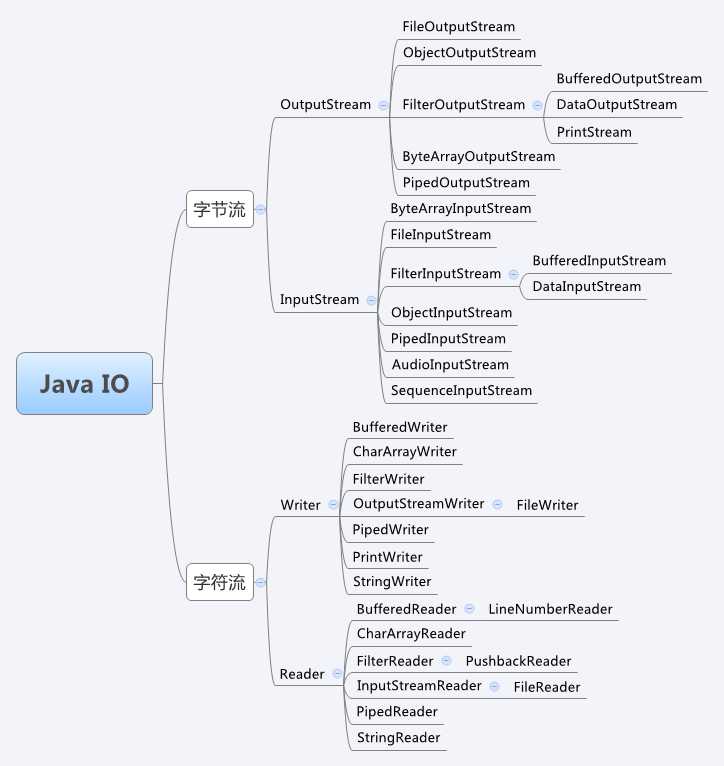标签:dom dex inpu system 文件读取 adl 打开 ted cep
首先JAVA IO为什么不叫文件而叫IO? IO其实是对文件或者网路的抽象,抽象成“流”,“流”是一维的,并且是hi单向流动的:从文件中读数据是流、向文件中写数据也是流、从网络中读数据是流、向网络中写数据也是流等等。
按数据走向来分可以分为输入流,输出流
按处理的数据类型可以分为字符流和字节流
首先要区分JAVA IO针对的对象, 把自己比作一个程序,向程序写数据就是Input操作,从程序向外输出数据就是Output操作
JAVA IO大致分为字节流和字符流。字节流:数据时二进制,人不可读,有InputStream, OutputStream接口。 字符流:数据是基于字符的,认识可读的,有Reader,Writer接口。
各种流的继承关系:

反正我第一次看见的时候很头疼,这么多类压根分不清,弄不明白。但是常用的有FileReader, BufferedReader, FileWriter,FileInputStream, FileOutputStream。具体用的时候可以参考API文档
下面结合实际,写一下代码看看具体的接口是如何使用的
File f = new File("src/Java/io/ReadMySelf.java");
System.out.println(f.exists()); //判断当前文件是否存在
System.out.println(f.getAbsolutePath()); //得到当前文件的绝对路径 F:\JavaLearning\src\Java\io\ReadMySelf.java
诸如此类的操作还有f.canRead(), f.canWrite(), f.canExcute(),f.creatNewFile()会判断当前文件是否存在,若不存在会生成新的文件
File[] files = f.listFiles(); //对files进行遍历可以的到当前文件下的所有文件目录
接下来展示用字符流来读取文件:
public class ReadMySelf { public static void main(String[] args) throws Exception { File f = new File("src/Java/io/ReadMySelf.java"); FileReader fr = null; try { fr = new FileReader(f); char[] buffer = new char[10]; int length = -1; while((length = fr.read(buffer)) != -1) { //每次读取10个字节 if(length == 10) { System.out.print(buffer); }else { System.out.println(new String(buffer, 0, length)); } } } catch(Exception e) { e.printStackTrace(); } finally { if(fr != null) { fr.close(); } }
}
也可以使用BufferedReader逐行读取
public class ReadMySelf { public static void main(String[] args) throws Exception { File f = new File("src/Java/io/ReadMySelf.java"); BufferedReader br = null; try { br = new BufferedReader(new FileReader(f)); String line = null; while((line = br.readLine()) != null) { System.out.println(line); } } catch(Exception e) { e.printStackTrace(); } finally { if(br != null) { br.close(); } } }
使用StringWriter/FileWriter写数据,这里采用StringWriter
public class ReadMySelf { public static void main(String[] args) throws Exception { File f = new File("src/Java/io/ReadMySelf.java"); StringWriter sw = new StringWriter(); BufferedReader br = null; try { br = new BufferedReader(new FileReader(f)); String line = null; while((line = br.readLine()) != null) { sw.write(line); sw.write("\n"); } System.out.println(sw.toString()); } catch(Exception e) { e.printStackTrace(); } finally { if(br != null) { br.close(); } }
}
下面才采用字节流来读取一个图片,并写入本地程序文件夹下:
public class ReadMySelf { public static void main(String[] args) throws Exception { BufferedInputStream bis = null; BufferedOutputStream bos = null; try { byte[] buffer = new byte[1024]; File f = new File("F:/JavaLearning/bd_logo.png"); System.out.println(f.exists()); bis = new BufferedInputStream(new FileInputStream("F:/JavaLearning/bd_logo.png")); bos = new BufferedOutputStream(new FileOutputStream("src/Java/io/a.png")); int length = -1; while((length = bis.read(buffer)) != -1) { bos.write(buffer, 0, length); } bos.flush(); } catch(Exception e) { } finally { bis.close(); bos.close(); } }
以上都是顺序读写文件,还可以使用RandomAccessFile随机读写文件,有两种模式“”rw“” “”r“”(只读)
RandomAccessFile raf=new RandomAccessFile (file,"rw")
内部包含一个文件指针,打开文件时指针在开头pointer=0;读写操作时指针会往后移动,使用seek(int index); 可以操作指针
public class ReadMySelf { public static void main(String[] args) throws Exception { RandomAccessFile file = new RandomAccessFile("src/Java/io/readme.txt", "rw");//若文件不存在会在本地创建 file.writeInt(20); //占4个字节 file.writeDouble(3.1415926); //占8个字节 file.writeUTF("这是一个UTF字符串"); //这个长度写在当前文件指针的前两个字节出,可以用readShort()读取 file.writeBoolean(true); //占1个字节 file.writeShort(155); //占2个字节 file.writeLong(1563231521); //占8个字节 file.writeUTF("又是一个UTF字符串"); file.writeFloat(35.12f); //占4个字节 file.writeChar(‘a‘); //占2个字节 file.seek(0); //把文件指针设置到文件起始处 //以下从file文件读取数据,要注意指针位置 System.out.println("-----------从file文件指定位置读取数据--------"); System.out.println(file.readInt()); System.out.println(file.readDouble()); System.out.println(file.readUTF()); file.skipBytes(3); //文件指针跳过三个字节 System.out.println(file.readLong()); }
以上是学JAVA IO时自己做的笔记,还有很多不足,自己还需努力。
标签:dom dex inpu system 文件读取 adl 打开 ted cep
原文地址:http://www.cnblogs.com/HarryHook/p/6579729.html